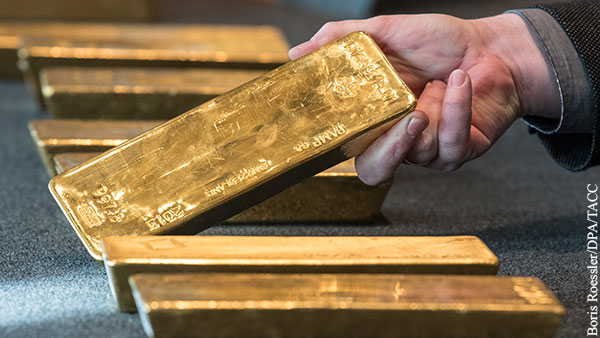Central banks began selling gold from reserves for the first time since 2010. Even Russia was noticed in this, which has not done this for 13 years. On the contrary, the Bank of Russia was actively buying gold to replenish its reserves. But there is no talk of a trend change. Moreover, the Central Bank has come up with a new way for Russia to make money off gold.
Central banks began selling gold for the first time since 2010. Even Russia took such a step, which happened for the first time in 13 years. Until now, global regulators, including the Bank of Russia, have been actively buying gold and replenishing their gold and foreign exchange reserves with it. And this is a well-thought-out strategy that is correct in the long term. Gold is a protective asset in case of global crises and cataclysms, it cannot be printed without stopping, and during a crisis its price seriously increases.
According to the World Gold Council, in the third quarter net sales of gold by global central banks amounted to 12.1 tons (against a net purchase of 141.9 tons a year earlier). The most active were Uzbekistan, which sold 34.9 tons of gold, and Turkey – 22.3 tons. Gold sellers in the third quarter also included Tajikistan (9.2 tons), the Philippines (7.8 tons), Mongolia (2.4 tons) and Russia (1.2 tons).
“The corona crisis and quarantines have led governments to use various reserves to support economies and local currencies. In many cases, this also affected gold, ”says Vladimir Bragin, Director for Financial Markets and Macroeconomics Analysis, Alfa Capital Management Company.
On the other hand, six central banks have increased their reserves: UAE, India, Qatar, Kyrgyzstan, Kazakhstan, Cambodia.
“There are two processes going on with gold at the same time. Banks with large reserves are selling metal to cope with the effects of the pandemic, especially since metal prices are high and the moment to sell is favorable. Other central banks, as well as commercial banks, investors and individuals buy gold in order to protect existing reserves from devaluation, ”says Artem Deev, head of the analytical department at AMarkets.
For example, Turkey is saving its currency and economy. “The Turkish lira has devalued against all currencies much more than the ruble has fallen against the dollar. At the same time, Turkey has few gold and foreign exchange reserves, so it had to sell gold for dollars in order to replenish the gold reserves and support the lira. Otherwise, the country was threatened by the Venezuelan scenario, when the country falls into hyperinflation, and the devaluation becomes catastrophic, “says Aleksey Vyazovsky, vice president of the Golden Mint House.
“For Uzbekistan, the sale of gold is quite a working way to replenish gold reserves. The country has no other way. What can be exported from Uzbekistan? Only workers and the gold that is mined there, ”continues Vyazovsky. “The Central Bank of Uzbekistan is constantly engaged in either purchases or sales of gold. He does not have a tendency towards constant gold sales, ”agrees Anton Prokudin, a leading methodologist of the Expert RA rating agency.
That is, one size fits all. “Each central bank solves its own problems. Do not take central bank gold sales as unusual. It’s a simple answer to the market situation, ”says Oksana Lukicheva, commodity analyst at Otkritie Broker.
Why did Russia start selling gold? In fact, we are talking about selling only 1.2 tons. And this can hardly be called a large-scale sale and a change in the strategy for buying gold, which the local regulator has been doing for the second decade.
“Russia has a completely different story than Turkey. We have a large volume of gold and foreign exchange reserves, and not only in gold, so we don’t have to sell it to support the ruble, ”says Vyazovsky.
“The Bank of Russia reacted to the growth of export requests and recorded a profit of 1.2 tons of metal. But relative to the accumulated reserves, this is a very small amount, ”says Lukicheva. For comparison, from the beginning of 2019 to March 2020, when the bank completed the purchase of gold, 196 tons of metal were added to the reserves.
This is most likely a purely technical story. “The Bank of Russia can sell gold to maintain target proportions between currencies and gold. He acted in a similar way last year, when the dollar-euro ratio was violated due to the active sale of dollars, ”explains Prokudin.
In recent years, Russia has been among the leaders in buying gold for the country’s reserves. As Lukicheva explains, this was done both with the aim of developing the gold mining industry and with the aim of additional emission into the Russian economy. But this year inflation may turn out to be higher than the target of 4%, so the regulator decided to suspend the purchase of gold in reserves so as not to provoke inflation acceleration even more. But when inflationary expectations normalize, the Central Bank of the Russian Federation may well return to buying gold, the expert said.
Due to the termination of the purchase of gold in reserves since March of this year, gold in bullion mined in Russia began to be actively sold abroad. As a result, in the second quarter, gold exports from Russia exceeded pipeline gas exports for the first time. The sale of 65.4 tons of gold earned $ 3.55 billion, and the sale of gas – only $ 2.4 billion (in April and May).
Apparently, such a success opened the eyes of the Russian regulator to the export possibilities of gold. At least, the other day the Bank of Russia announced a unique event. Starting from the new year, he will mint and sell the popular “George the Victorious” coins weighing an ounce. Up to 100,000 of these will be produced.
“Until now, Russia did not have its own international standard coin. The fact is that in the world gold is traded in ounces. It happened historically. An ounce is 31.1 grams. And we minted only a quarter ounce coin – 7.7 grams, ”says Aleksey Vyazovsky. According to him, the Bank of Russia made a real hell for two months by stopping the supply of George the Victorious to the market, creating a deficit. However, new batches of coins have finally entered the market and the situation has returned to normal.
“When the Ounce George the Victorious coins appear, they will be in demand all over the world. This means that Russia will be able to export gold not only in bars, but also in coins, ”says Vyazovsky.
Only institutional investors – stock exchanges (London or New York), banks and others – bought gold bullion. Whereas investment coins that are not subject to VAT, unlike bullion, can be bought by private individuals.
“Australia supplies its Kangaroo coins in millions of copies,“ American Eagle ”is sold around the world at 100-200 thousand coins per quarter. I think Europeans and other foreigners will gladly buy our coins. Russia will be able to get good foreign exchange earnings from this story. But, of course, the Central Bank, mints and dealers need to work hard so that our coin is recognized abroad, ”Vyazovsky concludes.
It is curious that, on the one hand, the demand for gold from the jewelry industry is declining. High metal prices and the consequences of the pandemic and quarantine also affect (mining in mines has decreased).
The largest consumers of jewelry gold have traditionally been the eastern countries, in particular, India and China. “But the more expensive gold, the less demand for it in the real economy. Moreover, there is a risk of increased receipts of scrap gold due to the crisis: in 1998, the price of gold collapsed with the development of the crisis in Southeast Asia, as the population began to actively donate jewelry in order to find means of living during the crisis, ”recalls Prokudin.
On the other hand, investment demand for gold is unabated. If we recall the financial crisis of 2008-2009, then the Central Bank of the Russian Federation then promptly increased the circulation to 1.5 million coins due to high demand. This time, the regulator decided to meet the growing demand not only within the country, but outside Russia.
Curiously, there is also industrial demand for gold. And, as it turned out, it also grows during the crisis. “In the electronics industry, in other industries and in dentistry, global demand for gold increased by 10-20% in the third quarter,” Deev notes.
–


